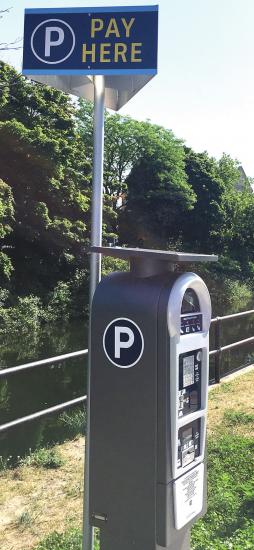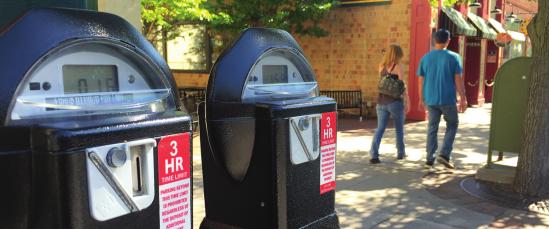Free Parking?
July 22, 2016
 Some In Traverse City Believe There’s No Such Thing
Some In Traverse City Believe There’s No Such Thing There aren’t many things as mundane as parking a car. It’s something you do between doing better things. But the act of parking, where you park, and how much you pay has become a heated topic in Traverse City.
Take an experiment in June, when the city proposed a pop-up park at Lot O, at the corner of State and Cass streets. Intended as a three-day dry run for a theoretical city square, the pop-up park sparked impassioned debate over whether space in the city should be reserved for parking or could be used for other activities.
One of the forums that drew both pop-up park supporters and dissenters was the Traverse City Ticker, an online sister publication of the Northern Express, which had reported on the pop-up.
One commenter called the experiment tone deaf: “We have constant issues with parking, and this is the plan … your tests to date have been failures … leave it alone and let people spend more time enjoying TC and not looking for parking spaces.”
Another cheered for the idea: “I love this idea and hope Traverse City gains a permanent Civic Square soon for people to gather at.”
Another commenter jeered: “The urban hipsters and downtown merchants win again. The rest of us lose.”
The reactions didn’t surprise Gary Howe, a city commissioner who advocates for inno-vative land use. “People who weren’t even parking there were riled up,” said Howe. But he noted that in reality, a lot of people liked the park: People gathered there to eat lunch. They sat on benches that typically go empty. They brought their kids down to draw on the lot with chalk and listen to live music.
Howe believes people want more nice places downtown where they can gather and hang out, and he envisions a town square as a way to transform State Street, which, compared to bustling Front Street, only a block north, is a quiet, underused strip of the city.
Downtown Development Authority (DDA) Executive Director Rob Bacigalupi agrees, and said he believes it’s worthwhile to think about how a town square could improve the vitality of State Street.
“I think it was a good exercise, and it was good to hear those criticisms and balance those with the value of the park,” he said. “We very much recognize that parking is in short supply and continues to be in shorter supply as time goes on.”
A POP-UP DISCUSSION
Debate over parking can expose raw emotions. Just ask Nicole VanNess, the Downtown Development Authority’s parking administrator who has overseen a stricter parking regime in her two years on the job. Parking rates have gone up, and staff who write parking tickets has increased. The changes have not escaped drivers’ notice.
“Parking is a very emotional thing. We’re tied to it. We’re tied to our cars,” she said, but she encourages people to look beyond their driver’s seat and consider the needs of an entire downtown. “You really have to take a step back and look at the big picture,” she said.
Part of the problem with parking, as Howe sees it, is that people take it for granted — because in so many places it’s free. But in reality, he said, everyone pays for parking indirectly; its cost is hidden in rent, real estate prices and the prices at stores and restaurants.
“All parking is subsidized at this point,” he said. “It just has this entrenched entitlement to it, because we’ve never had to pay for it.”
Howe believes if people understood what they really pay for parking, many would change their behavior — at least some of the time. He cited Munson Medical Center, which offers its employees free parking, as an example.
“That’s a bonus that the employees get that the employees don’t even recognize, because it’s not charged out,” Howe said.
But, he said, if Munson were to itemize parking as a benefit and put a $600 per year value on it, the hospital could offer each employee $600 in exchange for his or her parking space — a move that might motivate some employees to carpool, bike, or ride a BATA bus to work, ultimately freeing up space in the Munson parking deck and reducing traffic around the campus and its surrounding neighborhoods.
Howe said that the same incentive could apply to other locations, such as the 100 spots available at Traverse City’s Governmental Center, where parking is “free.” “That’s where we need to start,” he said.
“Parking should not be a given. It’s a choice.”
Howe’s idea for Traverse City might sound radical, but there’s a precedent in a significantly larger and more populous downtown in Michigan: Ann Arbor.
The southeast Michigan city, which had struggled for years with parking issues, implemented a successful parkand-ride program. And it works because area employers have offered meaningful incentives, said Jim Bruckbauer, policy specialist at Groundwork Center for Resilient Communities in Traverse City.
Bruckbauer believes Ann Arbor’s model could positively impact small and mediumsized cities like Traverse City and Petoskey.
To make the model work, though, employers offering staff a choice of a parking spot or the equivalent in cash is just the first step. The city itself must support the employers and employees by making improvements that ensure it’s safe and convenient for people to walk, bike, carpool, and take public transportation.
“The infrastructure has to be there,” Bruckbauer said. “I think there are a lot of people who would love to bike and walk into downtown, but they have to have safe options in order to do that.”
MISSION IMPOSSIBLE?
Paul Danielson understands that Traverse City’s parking rules are designed to nudge workers’ cars farther away from Front Street. He knows the higher meter rates, shorter time limits and stricter enforcement that have come along in recent years are meant to free up spots for customers.
But Danielson, co-owner of The Franklin, a restaurant located at Front and Cass streets, is frustrated because he believes the more stringent rules and pricier parking costs still aren’t changing behaviors. He said that despite the restrictions, he sees a lot of the same cars parked in front of his restaurant day after day, or for far longer than two hours at a time.
“If the point of two-hour parking and to make [parking at meters] more expensive is to push the employees into the parking decks, I don’t think it’s working,” Danielson said.
Danielson suspects that the DDA’s mission to enforce parking rules has only succeeded in building an expensive bureaucracy, one designed to raise money to build more parking decks.
“I get it: They’re trying to make money. They’re trying to build a system where they can pay for new parking decks,” Danielson said. “But it falls on the backs of the downtown people and the locals all winter, paying these rates that are crazy, to park downtown.”
Danielson said the recently hired ticket writers, dubbed “parking ambassadors” by the DDA, are too tenacious.
He points to a ticket he receive in February when he jumped out of his car on Union Street to run into a pharmacy. At the meter by his car, he pressed the button that allows 30 minutes of free parking. When he returned a few minutes later, he found a ticket on his car; the free time button hadn’t worked.
Danielson challenged the ticket, and it was forgiven, but he believes the experience was something that should not have happened to begin with.
Bacigalupi countered that the parking decks are doing what they were intended to do. “Our whole plan for downtown calls for taking parking out of surface lots, and putting them in vertical parking decks to free up land for more interesting things,” Bacigalupi said.
The transformation that a parking deck can cause is evident in Traverse City, Bacigalupi said. He points to the two decks the DDA has made happen: the Larry C. Hardy deck between Front and State streets, and the Old Town Parking Garage on Eighth Street, near Union.
“Once that thing was built, buildings popped up around it, and those surface lots went away,” Bacigalupi said. “What was hoped to happen did in fact happen. … At the end of the day, it’s not like we want cars downtown. We want people downtown.”
There is one point on which Danielson and Bacigalupi seem to agree: If Traverse City wants a walkable, dense downtown with lots of shops and restaurants and busy sidewalks, driving and parking behavior has to change. Whether that means fewer cars downtown; more walking, biking, and public transportation; or greater use of decks and lesser use of lots and street-side parking—or some combination thereof — remains to be seen.
PARKING TODAY …
Parking is supposed to be a self-sustaining, business-like enterprise, Bacigalupi said.
Some Traverse City parking revenue comes from fines, but the bulk of it comes from the primary ways that people pay for parking, generally by permit or hourly space rates. In the most recent fiscal year, total revenue was around $2.2 million.
Although parking patrols have increased in Traverse City since 2013, when the DDA added two part-time ticket writers to complement two full-time staff, projected revenue from fines was actually down — from a budgeted $335,000 to around $275,000.
In addition to the two parking decks the DDA has built, there is a vision to build a third on West Front Street. Time, however, is running out on that vision. Whereas Traverse City’s two public parking decks were funded largely through Tax Increment Financing — a means of diverting marginal taxes from increased property values to public improvement projects — one of the two TIF districts expired this year, so less money will be available to build a third parking deck. Bacigalupi said that means it will be necessary to use parking funds to pay for new projects.
“We know that there’s a ticking clock on the Tax increment Financing funding source,” Baciga-lupi said. “We’re still going to use TIF, but we need to rely on the parking fund to some degree.”
… AND PARKING TOMORROW
Any conversation about Traverse City’s future growth, or any new development within it, inevitably involves a lengthy discussion about parking.
“All you have to do is spend a couple days at city hall, and you will understand, almost everything is related back to parking,” Bacigalupi said.
“We’re always talking about parking. Parking is very important to economic development.”
Bacigalupi said a single parking spot costs about $2,500 per year to build and maintain, whether it’s on the surface or in a deck.
“It is very expensive to build and maintain parking spaces,” he said. “We’re not going to prevent everyone from driving downtown — we realize that. But to the extent that we can encourage folks to not drive or to carpool, basically to limit the number of times they bring a two-and-a-half-ton piece of metal downtown, that is to our benefit.”
The DDA plans to conduct a “transportation demand management” study this year to find out how it can best influence people’s behavior.
Bacigalupi said the ideal occupancy for parking is 85 to 90 percent. Hitting that means there are enough spots but not too many; people don’t have to drive around to hunt for a space.
Front Street — especially in the summer — sees occupancy well above capacity, he said.
A solution would be to make parking more expensive when demand is highest. Prices could change through the day or through the seasons. That would mean parking could be cheap in February when there are fewer people in town, but when summer festivals roll in, parking would cost a lot more.
“Let’s say on a busy July day [parking rates] might be higher and discourage everybody from driving their single occupancy vehicle downtown,” Bacigalupi said. “Maybe they might chose to bike or walk or carpool. They would be more inclined to do it.”
UP NEXT: PLATFORM CAFES?
One potential development raising that’s bound to get people talking is the prospect of platform cafes, small partitioned-off seating areas that would extend into the street, giving downtown res-taurants on those streets the ability to offer outdoor seating. Platform cafes would not be allowed on Front Street, but they’d take up a parking spot or two out in front of the adjacent restaurant.
Bacigalupi believes the trade-off would be fair.
“Yes, that will take away parking, but the ordinance that we’re working with would limit it so much that we don’t feel like it’s going to take away a significant amount,” he said. “You’re always balancing the need for parking with other things.”

Trending

Springtime Jazz with NMC
Award-winning vibraphonist Jim Cooper has been playing the vibraphone for over 45 years and has performed with jazz artist... Read More >>
Dark Skies and Bright Stars
You may know Emmet County is home to Headlands International Dark Sky Park, where uninterrupted Lake Michigan shoreline is... Read More >>
Community Impact Market
No need to drive through the orange barrels this weekend: Many of your favorite businesses from Traverse City’s majo... Read More >>


